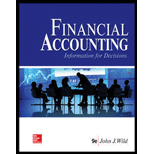
1.
Concept Introduction:
Gross margin is a percentage of profit on sales. It is calculated dividing the profit by the sales. Gross margin tells us the performance of the company.
To Calculate:
Gross margin of both the companies.
1.
Answer to Problem 2FSA
a. Company 1st => Year 1st = 21.19%
Year 2nd = 22.84%
b. Company 2nd => Year 1st = 21.57%
Year 2nd = 21.80%
Explanation of Solution
Gross Margin= Net Income/ Net Sales
2.
Concept Introduction:
Gross margin is a percentage of profit on sales. It is calculated dividing the profit by the sales. Gross margin tells us the performance of the company.
Current ratio is a ratio of the current assets and the current liabilities. It is calculated dividing the current assets by the current liabilities. It tells about the liquidity of the company.
Company successful on the basis of profit margin.
2.
Answer to Problem 2FSA
Year 1st = Company 2nd is better than company 1st.
Year 2nd = Company 1st is better than company 2nd.
Explanation of Solution
Year 1st = Company 2nd has gross margin of 21.57% which is slightly better than company 1st 21.19%. So company 2nd has better than company 1st.
Year 2nd = Company 1st has gross margin of 22.84% which is slightly better than company 2nd has 21.80%. So company 1st has better than company 2nd.
3.
Concept Introduction:
Gross margin is a percentage of profit on sales. It is calculated dividing the profit by the sales. Gross margin tells us the performance of the company.
Current ratio is a ratio of the current assets and the current liabilities. It is calculated dividing the current assets by the current liabilities. It tells about the liquidity of the company.
To Calculate:
Current Ratios of both the companies.
3.
Answer to Problem 2FSA
a. Company 1st => Year 1st = 1.353
Year 2nd = 1.109
b. Company 2nd => Year 1st = 6.29
Year 2nd = 4.67
Explanation of Solution
4.
Concept Introduction:
Gross margin is a percentage of profit on sales. It is calculated dividing the profit by the sales. Gross margin tells us the performance of the company.
Current ratio is a ratio of the current assets and the current liabilities. It is calculated dividing the current assets by the current liabilities. It tells about the liquidity of the company.
Company successful on the basis of Current Ratio.
4.
Answer to Problem 2FSA
Year 1st = Company 2 has better capacity to pay off his short term obligation than company 1.
Year 2nd = Company 2 has better capacity to pay off his short term obligation than company 1.
Explanation of Solution
Year 1st = Company 2nd has current ratio of 6.29 which is far better than the company 1st of 1.353. So company 2nd has better capacity to pay short term obligations.
Year 2nd = Company 2nd has current ratio of 4.67 which is far better than the company 1st of 1.109. So company 2nd has better capacity to pay short term obligations.
Want to see more full solutions like this?
Chapter 3 Solutions
Loose Leaf for Financial Accounting: Information for Decisions
- General accounting questionarrow_forwardObligations (amounts owed) are reported on the balance sheet and are referred to as __________..arrow_forwardBlueTech Corporation's balance sheet reports Assets of $8,400, Contributed Capital of $4,500, and Retained Earnings of $600. What is the total amount of liabilities on the balance sheet? a. $12,900 b. $3,300 c. $3,600 d. $8,100 e. None of the abovearrow_forward
- Principles of Accounting Volume 1AccountingISBN:9781947172685Author:OpenStaxPublisher:OpenStax College
 Financial And Managerial AccountingAccountingISBN:9781337902663Author:WARREN, Carl S.Publisher:Cengage Learning,
Financial And Managerial AccountingAccountingISBN:9781337902663Author:WARREN, Carl S.Publisher:Cengage Learning,



